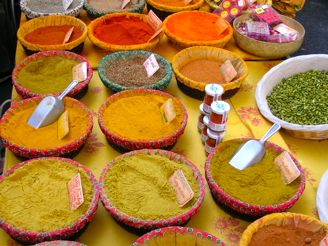
market, l
(post, Caroline Lewis)
I asked my oldest son, Mike — a passionate young cook and gastronome — what he thought I should write about in my next Culinate posting. He immediately replied, "Soupe au pistou! I’ve been craving that lately.” Anyone who’s ever had a really good version of this delicious dish can understand why. There are probably as many soupes au pistou (literal translation: pesto soups) as there are Provençal cooks. As with most such “recipes,” soupe au pistou isn’t so much a recipe as a construct, a French version of minestrone characterized by the heavenly dollop of pesto swirled in just before serving. It’s little wonder, then, that there’s a fair amount of confusion about what exactly this dish is. I think most soupe au pistou recipes call for too many ingredients, many of which aren’t in season at the same time: zucchini and winter squash, for example. Or they might include both green beans and dried beans, or new spring potatoes as well as overwintering leeks. [%image market float=right width=400 caption="The market in St. Rémy."] The best soupe au pistou I ever made was, not surprisingly, in Provence in the middle of summer (and this is precisely why Mike remembers it so well). My family has a house in St. Rémy within walking distance of the wonderful twice-weekly farmers' market. Wednesday is the big market day in St. Rémy, and we never miss it when we’re there. That day I bought Roma tomatoes, yellow and green beans, fennel, garlic, carrots, new potatoes, and, of course, basil. The vegetables had been picked that morning and were being devoured by early afternoon. I can still smell the heady scent of that garlicky pot of soup. This time of year, I can still make a similar dish, but there are two tricks to it. First of all, I use different vegetables. I add turnips and Swiss chard, substitute dried flageolets for green beans, canned Romas for fresh, and reluctantly skip the fennel. In another couple of months, I’ll probably throw in some freshly harvested shelling peas, too. Secondly, we have a stash of pesto in our freezer. Larry and I grow several Genovese basil plants in our raised beds each summer, cutting leaves and making and freezing batches of pesto as we go. By end of summer we typically have a dozen batches stashed away for chilly winter evenings when Provençal summer food is just a memory. [%image reference-image float=left width=400 caption="Spices at the market."] My favorite pesto recipe is Marcella Hazan’s. Although pistou is not technically the same thing as pesto, it’s really close (the French often add tomatoes to their version). I’ve never had better pesto than Hazan’s. Her Essentials of Classic Italian Cooking includes recipes for both the traditional mortar-and-pestle method (which is where the name “pesto” comes from) and the modern version made in a food processor. For freezing, Hazan recommends leaving out the Romano and Parmigiano cheeses and butter, adding them to the sauce when it’s thawed for a fresher flavor. Honestly, I’ve frozen it with and without the cheeses and butter, and it’s pretty terrific either way. In either case, be sure to use only top-quality imported Italian cheeses. [[block(sidebar). h1.Featured recipes]] Note her recipe makes enough for 1 1/2 pounds of pasta. So when we make up a batch, we use two-thirds of it to sauce one pound of pasta, then use the remaining third for our soupe au pistou. Here’s my very early spring soupe au pistou recipe, a tonic for this time of year and a reminder of those summer days to come. (I’ll publish a summer recipe as well when the time is right.) If you don’t happen to have pesto stashed in your freezer, you can purchase it for now. But please do find a sunny spot in your vegetable or flower garden, or in a couple of large pots, to grow your own basil this year. By next March — if not a whole lot sooner — you’ll be thankful you did.

market, l

reference-image, l